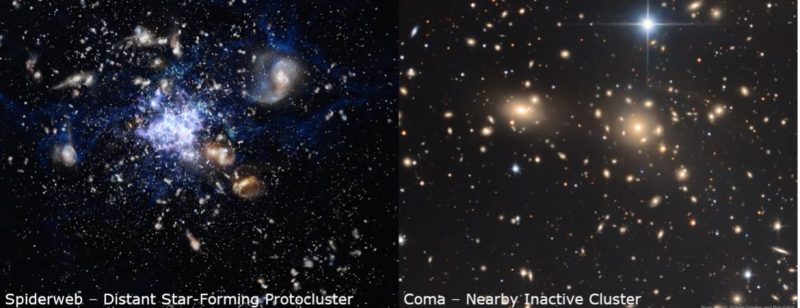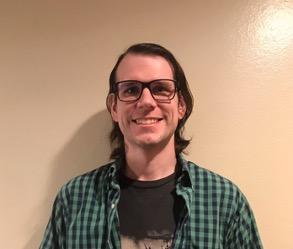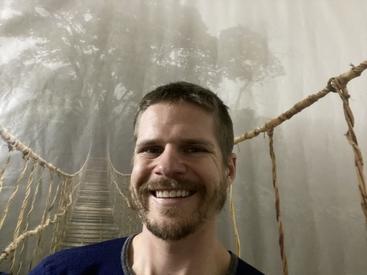
An unusual galaxy cluster
Stars form in a range of colors, from blue to red. The most massive stars are blue and very hot, but these stars don’t live very long. They live only a few hundred million years, in contrast to billions of years for stars like our sun. So when astronomers look out in space and see lots of hot, young, massive blue stars, they know they’re seeing a place where stars are actively forming.
You’d expect active star formation in the early universe, when all things were just beginning. And indeed, when they look far out into space (and therefore far back in time), astronomers do see active, blue star-forming regions. But a newly analyzed protocluster, or newborn galaxy cluster, bucks that trend. It appears to exist in the early universe. But it looks old, red and dead. A team of astronomers from the University of California Riverside announced the unusual findings on February 9, 2022.
The peer-reviewed Astrophysical Journal published these findings on February 9, 2022.
Scientists have named this divergent galaxy cluster MAGAZ3NE J095924+022537. The weighty name is because it was found with the Massive Ancient Galaxies At Z > 3 NEar-infrared survey, or MAGAZ3NE survey. Ian McConachie of UC Riverside is lead author. He said:
In the early universe, all protoclusters discovered until now are full of vigorously star-forming galaxies. But incredibly, unlike all of the other protoclusters that have been found at this epoch, many galaxies in MAGAZ3NE J0959 appear to have already stopped forming stars.

Old cluster in the young universe
The galaxy cluster MAGAZ3NE J0959 has at least 38 member galaxies and is about 11.8 billion light-years away from Earth. As the universe ages, galaxy clusters from the young universe grow larger, with hundreds or thousands of galaxies brought together under their gravity. These massive galaxy clusters evolve through time from young, blue, star-forming clusters to old, red, dead clusters. So the new discovery looks more like current-day clusters than its contemporaries in the early universe.
Author Gillian Wilson of the University of California Riverside said:
We are seeing this protocluster as it appeared when the universe was less than 2 billion years old. It is as if you took a cluster like Coma, the nearest rich cluster of galaxies to Earth, and plopped it into the early universe.

A closer look at the galaxy cluster
At the core of this unusual galaxy cluster is an ultramassive galaxy that has already formed more than 200 billion suns. Benjamin Forrest, formerly of UC Riverside and now at the University of California Davis and an author on the paper, said:
Why this ultramassive galaxy and so many of its neighbors formed most of their stars and then became inactive when the universe was still so young, in contrast to other known protoclusters from the same time, is a big mystery. Why its galaxies are so unlike those in all the other known protoclusters, and so similar to those in Coma, is a complete mystery.
The MAGAZ3NE survey was a ground-based survey, but astronomers are excited for the James Webb Space Telescope to come online and open up new windows to the early universe. Forrest said:
Should such protoclusters be found in large numbers, it would mean that the current paradigm of protocluster formation would require a major revision. A new scenario of protoclusters existing in a diversity of states in the early universe would have to be adopted. With many member galaxies quenching in the first two billion years, this would almost certainly pose significant challenges for current models of galaxy simulation.

Next steps
The scientists said they still want to learn under what conditions and in what environments these ultramassive galaxies form. Next, they said, they’ll study the neighborhood of all other ultramassive galaxies in the MAGAZ3NE survey, hoping to unlock the secrets hidden there.
Bottom line: Astronomers have found a galaxy cluster in the early universe unlike other clusters from its era. The newborn cluster, called MAGAZ3NE J095924+022537, has old, red, dead stars.
The post Why so many dead galaxies in this galaxy cluster? first appeared on EarthSky.
from EarthSky https://ift.tt/pgAak0u

An unusual galaxy cluster
Stars form in a range of colors, from blue to red. The most massive stars are blue and very hot, but these stars don’t live very long. They live only a few hundred million years, in contrast to billions of years for stars like our sun. So when astronomers look out in space and see lots of hot, young, massive blue stars, they know they’re seeing a place where stars are actively forming.
You’d expect active star formation in the early universe, when all things were just beginning. And indeed, when they look far out into space (and therefore far back in time), astronomers do see active, blue star-forming regions. But a newly analyzed protocluster, or newborn galaxy cluster, bucks that trend. It appears to exist in the early universe. But it looks old, red and dead. A team of astronomers from the University of California Riverside announced the unusual findings on February 9, 2022.
The peer-reviewed Astrophysical Journal published these findings on February 9, 2022.
Scientists have named this divergent galaxy cluster MAGAZ3NE J095924+022537. The weighty name is because it was found with the Massive Ancient Galaxies At Z > 3 NEar-infrared survey, or MAGAZ3NE survey. Ian McConachie of UC Riverside is lead author. He said:
In the early universe, all protoclusters discovered until now are full of vigorously star-forming galaxies. But incredibly, unlike all of the other protoclusters that have been found at this epoch, many galaxies in MAGAZ3NE J0959 appear to have already stopped forming stars.

Old cluster in the young universe
The galaxy cluster MAGAZ3NE J0959 has at least 38 member galaxies and is about 11.8 billion light-years away from Earth. As the universe ages, galaxy clusters from the young universe grow larger, with hundreds or thousands of galaxies brought together under their gravity. These massive galaxy clusters evolve through time from young, blue, star-forming clusters to old, red, dead clusters. So the new discovery looks more like current-day clusters than its contemporaries in the early universe.
Author Gillian Wilson of the University of California Riverside said:
We are seeing this protocluster as it appeared when the universe was less than 2 billion years old. It is as if you took a cluster like Coma, the nearest rich cluster of galaxies to Earth, and plopped it into the early universe.

A closer look at the galaxy cluster
At the core of this unusual galaxy cluster is an ultramassive galaxy that has already formed more than 200 billion suns. Benjamin Forrest, formerly of UC Riverside and now at the University of California Davis and an author on the paper, said:
Why this ultramassive galaxy and so many of its neighbors formed most of their stars and then became inactive when the universe was still so young, in contrast to other known protoclusters from the same time, is a big mystery. Why its galaxies are so unlike those in all the other known protoclusters, and so similar to those in Coma, is a complete mystery.
The MAGAZ3NE survey was a ground-based survey, but astronomers are excited for the James Webb Space Telescope to come online and open up new windows to the early universe. Forrest said:
Should such protoclusters be found in large numbers, it would mean that the current paradigm of protocluster formation would require a major revision. A new scenario of protoclusters existing in a diversity of states in the early universe would have to be adopted. With many member galaxies quenching in the first two billion years, this would almost certainly pose significant challenges for current models of galaxy simulation.

Next steps
The scientists said they still want to learn under what conditions and in what environments these ultramassive galaxies form. Next, they said, they’ll study the neighborhood of all other ultramassive galaxies in the MAGAZ3NE survey, hoping to unlock the secrets hidden there.
Bottom line: Astronomers have found a galaxy cluster in the early universe unlike other clusters from its era. The newborn cluster, called MAGAZ3NE J095924+022537, has old, red, dead stars.
The post Why so many dead galaxies in this galaxy cluster? first appeared on EarthSky.
from EarthSky https://ift.tt/pgAak0u

Aucun commentaire:
Enregistrer un commentaire